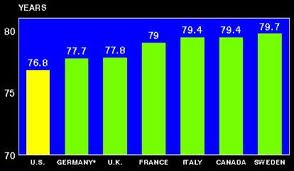 If you look at the raw data on life expectancy at birth in industrialized countries, you’ll notice right away that Americans are pretty close to the bottom of the pile. And while life expectancy in the US has increased over time, we haven’t kept pace with other high-income countries. The fact that Americans live shorter lives is alarming, but before jumping to any conclusions about the quality of our healthcare system, it’s important to understand exactly why it’s happening. And that’s exactly what Jessica Ho, a doctoral candidate in demography and sociology at the University of Pennsylvania, in Philadelphia, did.
If you look at the raw data on life expectancy at birth in industrialized countries, you’ll notice right away that Americans are pretty close to the bottom of the pile. And while life expectancy in the US has increased over time, we haven’t kept pace with other high-income countries. The fact that Americans live shorter lives is alarming, but before jumping to any conclusions about the quality of our healthcare system, it’s important to understand exactly why it’s happening. And that’s exactly what Jessica Ho, a doctoral candidate in demography and sociology at the University of Pennsylvania, in Philadelphia, did.
According to Ho, the big problem is the difference in the rate of premature death among those 50 and under. Specifically, she found that for men under 50, mortality differences accounted for two thirds of the life expectancy gap. For women, premature mortality under 50 accounted for 40 percent of the gap.
The biggest differences? Well, to start with, 64% of deaths under 50 were caused by accidental poisonings—91% of those were drug overdoses. Homicides accounted for 20 percent of the mortality difference for men and 10 percent for women. And while the number of deaths per 100 million kilometers driven is pretty much the same across all industrialized countries, Americans drive far more than most others.
Ho also found that Americans had higher prevalence of anxiety, mood, impulse control, and substance abuse disorders. The connection between poor mental health and increased mortality rates is very well established.
“This study suggests that if the goal is to reduce the U.S. life expectancy shortfall, more attention should be paid to health and mortality conditions at younger ages,” Ho wrote.
You can read an abstract of the article here.



